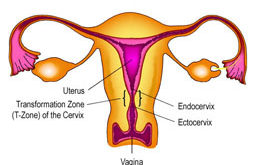What causes cervical cancer?
Human papillomavirus (HPV) is found in about 99% of cervical cancers. There are over 100 different types of HPV, most of which are considered low-risk and do not cause cervical cancer. High-risk HPV types may cause cervical cell abnormalities or cancer. More than 70 percent of cervical cancer cases can be attributed to two types of the virus, HPV-16 and HPV-18, often referred to as high-risk HPV types.
HPV is estimated to be the most common sexually transmitted infection in the United States. In fact, by age 50 approximately 80% of women have been infected with some type of HPV. The majority of women infected with the HPV virus do NOT develop cervical cancer. For most women the HPV infection does not last long; 90% of HPV infections resolve on their own within 2 years. A small number of women do not clear the HPV virus and are considered to have “persistent infection. A woman with a persistent HPV infection is at greater risk of developing cervical cell abnormalities and cancer than a woman whose infection resolves on its own. Certain types of this virus are able to transform normal cervical cells into abnormal ones. In a small number of cases and usually over a long period of time (from several years to several decades), some of these abnormal cells may then develop into cervical cancer.
Symptoms of Cervical Cancer
Precancerous cervical cell changes and early cancers of the cervix generally do not cause symptoms. For this reason, regular screening through Pap and HPV tests can help catch precancerous cell changes early and prevent the development of cervical cancer.
Possible symptoms of more advanced disease may include abnormal or irregular vaginal bleeding, pain during sex, or vaginal discharge. Notify your healthcare provider if you experience:
- Abnormal bleeding, such as
- Bleeding between regular menstrual periods
- Bleeding after sexual intercourse
- Bleeding after douching
- Bleeding after a pelvic exam
- Bleeding after menopause
- Pelvic pain not related to your menstrual cycle
- Heavy or unusual discharge that may be watery, thick, and possibly have a foul odor
- Increased urinary frequency
- Pain during urination
These symptoms could also be signs of other health problems, not related to cervical cancer. If you experience any of the symptoms above, talk to a healthcare provider.
 Female Cancer Specialist Doctor in Kanpur female, doctor, cancer, specialist, female, oncologist, oncology, medical, oncologist, chemotherapy, breast, blood, mammography, prostate, center, hospital, radiotherapy, surgery, mouth, kanpur, sn, memorial, female, doctor, cancer, specialist,
Female Cancer Specialist Doctor in Kanpur female, doctor, cancer, specialist, female, oncologist, oncology, medical, oncologist, chemotherapy, breast, blood, mammography, prostate, center, hospital, radiotherapy, surgery, mouth, kanpur, sn, memorial, female, doctor, cancer, specialist,



